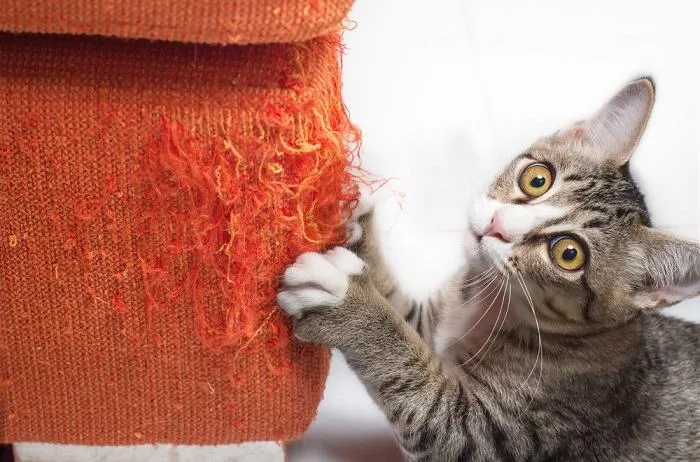Cats bring joy and companionship, but their independent nature can lead to frustrating behaviors like scratching furniture, biting, or excessive meowing. If you’re wondering how to teach your cat no, you’re not alone—many cat owners struggle with these issues. Understanding why cats misbehave and using consistent training techniques can help maintain a harmonious home. Cats are intelligent and responsive to body language, tone, and repetition, making basic commands like “no” achievable with patience.
For related tips on managing playful aggression, check out how to discipline kittens for biting.
 An image featuring a person teaching a cat the command
An image featuring a person teaching a cat the command
Common Reasons for Cat Misbehavior
Cats exhibit natural behaviors that might seem naughty to us, such as aggression, inappropriate elimination, or vocalizing excessively. These actions often stem from instinct, stress, or unmet needs rather than deliberate defiance. Identifying the root cause is the first step in effective training, ensuring you address the issue compassionately while teaching boundaries.
Aggression Toward People or Other Cats
Aggression, including biting, hissing, or pouncing, can arise from fear, anxiety, play frustration, or underlying pain. Kittens often bite during play, but this escalates in adults if not corrected early. A veterinary check is essential to rule out health issues, as recommended by the American Association of Feline Practitioners (AAFP).
For multi-cat homes, territorial disputes may cause fights. Provide ample resources like separate litter boxes, food stations, and vertical spaces to reduce tension.
 A cat seeking attention from its owner.
A cat seeking attention from its owner.
Inappropriate play is common; redirecting energy with toys prevents escalation. Consistent “no” commands paired with positive alternatives work wonders.
 Two tabby cats engaged in a playful fight.
Two tabby cats engaged in a playful fight.
Inappropriate Toileting
Cats urinating or defecating outside the litter box often signals medical problems like urinary tract infections (UTIs) or stress. Differentiate between spraying (standing, vertical surfaces, small amounts) and normal urination (squatting, horizontal, larger volume). Clean the box daily, ensure privacy, and consult a vet promptly.
Stress from household changes can trigger this; pheromone diffusers like Feliway may help, per veterinary studies.
 An unfortunate scene of a cat urinating on a carpet.
An unfortunate scene of a cat urinating on a carpet.
Scratching Furniture and Excessive Vocalization
Scratching maintains claws and marks territory via pheromones—it’s essential but redirectable. Offer sturdy posts treated with catnip. Excessive meowing seeks attention, food, or expresses discomfort; ignore attention-seeking while rewarding quiet behavior.
 A DIY cat scratcher project. The image showcases a person crafting a cat scratcher using various materials.
A DIY cat scratcher project. The image showcases a person crafting a cat scratcher using various materials.
Vocal cats respond to scheduled interactions, reducing demands.
 A defensive kitten hissing in response to a perceived threat.
A defensive kitten hissing in response to a perceived threat.
Climbing and Exploration
Cats climb for security and curiosity, but it risks falls. Secure hazardous areas and use “no” to intervene safely.
 A cat engaged in climbing and exploring.
A cat engaged in climbing and exploring.
Can Cats Learn Commands Like “No”?
Yes, cats can be trained despite their independent reputation. Comparable to a 2-3-year-old child’s intelligence, they grasp concepts through repetition, positive reinforcement, and consistency. Key principles include patience, understanding instincts, and short sessions (5-10 minutes daily).
Motivators vary: treats, toys, or affection. Avoid punishment, which breeds fear—focus on redirection.
 A well-trained cat showcasing its skills. The image features a cat confidently performing a trained behavior or trick.
A well-trained cat showcasing its skills. The image features a cat confidently performing a trained behavior or trick.
To build affection alongside training, explore ways to train cat to cuddle.
Step-by-Step Guide: Teaching Your Cat “No”
Consistency is crucial—use the same firm tone, posture, and word every time.
- Interrupt the Behavior: Spot unwanted action (e.g., scratching sofa). Say “no” loudly and firmly, standing tall with eye contact.
- Physically Redirect: Gently move the cat away, associating “no” with stopping.
- Offer Alternative: Place on scratching post or give toy. Praise/reward immediately.
- Repeat Daily: Practice in real scenarios. Add a hiss for emphasis if needed, but never yell.
Over weeks, cats link “no” to cessation via tone and body language, not the word itself.
 An inquisitive cat next to a scratched piece of furniture.
An inquisitive cat next to a scratched piece of furniture.
From personal experience fostering rescues, kittens learn fastest before 6 months, but adults adapt too with 4-6 weeks of routine.
 A mischievous cat causing chaos near a Christmas tree.
A mischievous cat causing chaos near a Christmas tree.
Troubleshoot plateaus by varying rewards or enlisting family consistency.
 A frustrated owner trying to prevent a cat from knocking over objects.
A frustrated owner trying to prevent a cat from knocking over objects.
Conclusion
Teaching your cat “no” fosters respect and curbs misbehaviors like aggression, scratching, or toileting issues. Patience, repetition, and veterinary input ensure success while preserving your bond. Start today for a calmer home—your feline will thrive with clear boundaries.
Consult a certified cat behaviorist if issues persist, as per International Cat Care guidelines.
Frequently Asked Questions
How do I stop my cat from biting or scratching?
Say “no” firmly, redirect to toys, and provide alternatives. Rule out pain with a vet visit first.
Why doesn’t my cat listen to “no”?
Cats respond to tone and posture over words. Consistent repetition builds understanding.
Can all cats be trained?
Most can, with tailored motivation. Kittens learn quickest, but adults succeed through daily practice.
References:
- American Association of Feline Practitioners (AAFP) Guidelines on Feline Behavior.
- International Cat Care: Cat Training Resources.
- Original insights from cats.com veterinary contributors.
